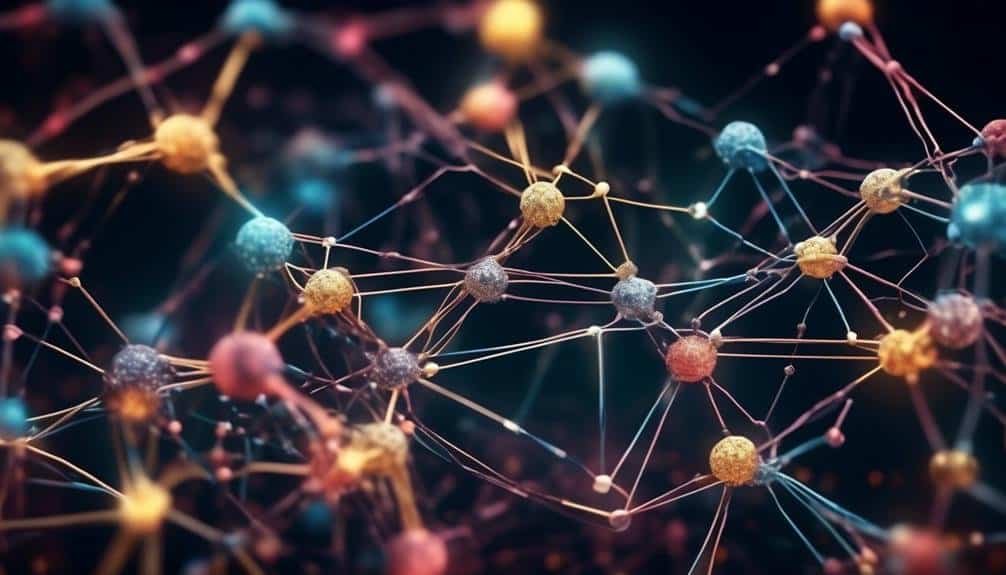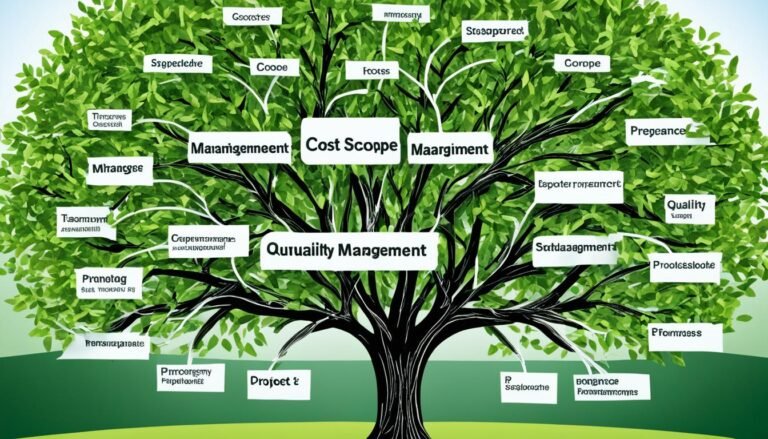Dependency Mapping: Understanding Interconnections in Your Project
|
Getting your Trinity Audio player ready...
|
In today's fast-paced and interconnected business environment, it is essential for project managers to have a clear understanding of the interdependencies within their projects. Dependency mapping provides a systematic approach to unraveling the complex web of relationships between tasks, resources, and deliverables.
By identifying and analyzing these interconnections, project managers can gain valuable insights into potential bottlenecks, critical paths, and risks that may impact project success.
In this discussion, we will explore the basics of dependency mapping, the key benefits of understanding interconnections, and the tools and techniques that can be employed to effectively map dependencies.
So, let's dive into the world of dependency mapping and uncover the hidden intricacies that can make or break your project.
Key Takeaways
- Dependency mapping techniques are crucial for understanding the interconnections in a project and optimizing resource allocation.
- Visualizing dependency maps using tools like Gantt charts or network diagrams helps in identifying the critical path and prioritizing tasks.
- Understanding project interdependencies leads to enhanced coordination, proactive risk management, and improved efficiency.
- Using mapping software like Lucidchart, Microsoft Visio, or Jira Dependency Mapping can greatly improve project planning, communication, and efficiency.
The Basics of Dependency Mapping
In order to effectively manage the relationships and interdependencies between various components in your project, it is essential to have a solid understanding of the basics of dependency mapping. Dependency mapping techniques play a crucial role in identifying and visualizing the relationships between different tasks, activities, and resources in a project. By understanding project interdependencies, you can ensure that the project progresses smoothly and that all the necessary components are delivered on time.
Dependency mapping involves identifying the dependencies between various tasks and activities in a project. These dependencies can be classified into four types: finish-to-start, start-to-start, finish-to-finish, and start-to-finish. Understanding these dependencies helps project managers identify the critical path and prioritize tasks accordingly.
To create an effective dependency map, project managers need to gather information about the project's tasks, milestones, deliverables, and resources. This information can be obtained through team discussions, project documentation, and stakeholder interviews. Once the information is collected, it can be visualized using tools such as Gantt charts or network diagrams.
Key Benefits of Understanding Interconnections
Understanding the interconnections between various tasks and activities in a project provides project managers with valuable insights and advantages for effective project management. By recognizing the dependencies and relationships between different components of a project, managers can better plan and execute tasks, ultimately leading to improved project success.
Some key benefits of understanding interconnections include:
- Enhanced coordination: When project managers have a clear understanding of interdependencies, they can effectively coordinate and schedule activities to ensure smooth execution. This helps in avoiding bottlenecks and delays, leading to improved project timelines.
- Risk management: Interconnections can reveal potential risks and dependencies that may impact project success. By identifying these early on, project managers can proactively manage risks and develop contingency plans to mitigate their impact.
- Resource optimization: Understanding interconnections allows project managers to allocate resources more efficiently. By identifying where resources are most needed and where they can be shared across tasks, managers can optimize resource utilization, reducing costs and improving efficiency.
The impact of interdependencies on project success cannot be underestimated. Effective understanding and management of interconnections contribute to improved coordination, risk management, and resource optimization, ultimately leading to successful project outcomes. Project managers who recognize and leverage the benefits of understanding interconnections are better equipped to drive project success and achieve organizational goals.
Tools and Techniques for Dependency Mapping
When it comes to dependency mapping, utilizing the right tools is crucial for effective project management.
Mapping software options provide a systematic approach to identify and analyze dependencies within a project.
Network analysis techniques, on the other hand, allow for a more in-depth understanding of the relationships between different components.
Lastly, visualizing dependencies effectively through charts, diagrams, or other visual aids can help stakeholders grasp the complexity of interconnections and make informed decisions.
Mapping Software Options
To effectively map software dependencies, it is essential to explore a range of available tools and techniques. Mapping software can greatly assist in visualizing and understanding the complex interconnections within a project. Here are three popular options for mapping software:
- Lucidchart: This cloud-based tool offers a user-friendly interface and allows for easy collaboration. It provides various templates and shapes to create comprehensive dependency diagrams.
- Microsoft Visio: Known for its versatility, Visio offers a wide range of features for mapping dependencies. It allows users to create detailed diagrams and customize them to suit their specific needs.
- Jira Dependency Mapping: This tool is specifically designed for software development projects and integrates seamlessly with Jira. It automatically tracks and visualizes dependencies between tasks, making it easier to identify potential bottlenecks and optimize workflows.
Using mapping software offers several benefits, including improved project planning, enhanced communication, and increased efficiency. By visually representing dependencies, teams can better understand the complexity of their projects and make informed decisions.
Network Analysis Techniques
Network analysis techniques provide valuable tools and methods for accurately mapping dependencies within a project. These techniques help project managers identify the relationships and interdependencies between various tasks, allowing for better planning and decision-making. There are several network analysis tools and techniques available that can aid in this process.
One commonly used tool is the Network Diagram, which visually represents the project tasks and their dependencies. This diagram helps to identify the critical path and determine the project's overall duration. Another technique is the Critical Path Method (CPM), which calculates the longest path of dependent activities and determines the project's minimum duration.
Additionally, the Program Evaluation and Review Technique (PERT) is useful for estimating project duration by considering uncertainties and risks. It uses three estimates for each task – optimistic, pessimistic, and most likely – to calculate the expected duration.
The table below summarizes some popular network analysis tools and techniques:
| Tool/Technique | Description |
|---|---|
| Network Diagram | Visual representation of project tasks and their dependencies |
| Critical Path Method (CPM) | Calculates the longest path and determines project duration |
| Program Evaluation and Review Technique (PERT) | Estimates project duration considering uncertainties and risks |
| Dependency Structure Matrix (DSM) | Identifies and visualizes dependencies between project elements |
| Graph Theory | Analyzes relationships between elements in the project network |
Visualizing Dependencies Effectively
To effectively visualize dependencies in a project, project managers can utilize various tools and techniques that facilitate dependency mapping and provide valuable insights into the relationships and interdependencies between project tasks. By utilizing graphical representations, project managers can easily identify critical path dependencies, analyze the impact of delays or changes in one task on the entire project, and make informed decisions to mitigate risks and optimize project timelines.
Some effective visualization techniques include:
- Gantt charts: These visually represent project tasks and their dependencies in a timeline, allowing project managers to easily identify the order and relationship between tasks.
- Network diagrams: These diagrams illustrate the flow and interdependencies between tasks using nodes and arrows, providing a comprehensive view of the project structure.
- Dependency matrix: This matrix helps project managers identify the dependencies between tasks by listing them in a tabular format, making it easier to track and manage dependencies.
Identifying Dependencies in Your Project
Dependencies in your project can be identified by analyzing the relationships between different components and the impact they have on each other. This process, known as dependency tracking, allows you to understand the interconnections within your project and identify potential risks or bottlenecks.
To identify dependencies, you need to conduct a thorough impact analysis. This involves examining how changes in one component can affect other components and the overall project. By understanding these dependencies, you can effectively plan and manage your project, ensuring that any changes or updates are implemented smoothly.
One way to identify dependencies is by analyzing the flow of data or information between components. This could involve examining input-output relationships or data dependencies. For example, if a component relies on the output of another component, there is a dependency between them.
Another approach is to analyze the functionality or behavior of different components. This can help identify dependencies based on the interactions between components. For instance, if a change in one component requires modifications in another component to maintain functionality, there is a dependency between them.
Furthermore, dependencies can also be identified by considering the timing or sequence of activities. If one component needs to be completed before another can start, there is a dependency between them.
Analyzing Interdependencies for Effective Planning
Analyzing the interdependencies within your project is crucial for effective planning and ensuring a smooth execution of tasks. By understanding the relationships between different tasks and deliverables, you can identify potential bottlenecks, dependencies, and risks that may impact the overall progress of your project.
Here are three key reasons why analyzing dependencies is essential for planning effectiveness:
- Identifying critical path: Analyzing interdependencies helps you identify the critical path, which is the sequence of tasks that must be completed on time for the project to finish successfully. By understanding the critical path, you can prioritize tasks, allocate resources effectively, and ensure that no delays occur that may impact the project's timeline.
- Managing risks: Analyzing dependencies allows you to identify potential risks and their impact on the project. By understanding the dependencies, you can proactively plan for contingencies, allocate resources accordingly, and minimize the impact of any unforeseen events.
- Optimizing resource allocation: Analyzing dependencies helps you identify resource requirements for each task and understand how different tasks rely on shared resources. This allows you to optimize resource allocation, avoid resource conflicts, and ensure that all required resources are available when needed.
Resolving Bottlenecks and Critical Path Analysis
Resolving bottlenecks and conducting critical path analysis are crucial steps in effectively managing project dependencies.
To identify bottlenecks, various techniques can be employed, such as analyzing resource allocation, identifying process inefficiencies, and evaluating task dependencies.
Analyzing critical dependencies involves identifying the tasks that have the greatest impact on project timelines and ensuring that they are managed efficiently to minimize delays and maximize project success.
Bottleneck Identification Techniques
Effective project management involves identifying and addressing bottlenecks through techniques such as critical path analysis and resolution strategies. Bottlenecks are constraints that slow down the progress of a project, affecting its overall efficiency and timely completion. By applying bottleneck identification techniques, project managers can optimize workflow and ensure smooth project execution.
Here are three key techniques for identifying bottlenecks:
- Analyzing resource utilization: This involves examining how resources are allocated and utilized throughout the project. By identifying resources that are frequently overburdened or underutilized, project managers can pinpoint potential bottlenecks and take appropriate actions.
- Conducting process flow analysis: This technique involves mapping out the various steps and activities involved in the project. By analyzing the flow of work and identifying areas where delays occur or dependencies are not being met, project managers can identify bottlenecks and implement strategies to overcome them.
- Utilizing critical path analysis: Critical path analysis helps identify the longest sequence of dependent activities in a project, known as the critical path. By focusing on activities along the critical path, project managers can identify potential bottlenecks that may impact the project timeline and take corrective actions.
Analyzing Critical Dependencies
To effectively address bottlenecks and ensure timely project completion, it is crucial to analyze critical dependencies and implement strategies to resolve them.
Analyzing bottlenecks involves identifying the tasks or activities that are causing delays or hindering progress in a project. By understanding these bottlenecks, project managers can prioritize their efforts and allocate resources effectively.
One method for analyzing bottlenecks is by identifying critical paths. A critical path is the sequence of tasks that determines the minimum amount of time required to complete a project. By identifying the tasks that fall on the critical path, project managers can focus their attention on these activities to ensure they are completed on time.
Once the critical dependencies are identified, strategies can be implemented to resolve them. This may involve reallocating resources, adjusting timelines, or reassigning tasks to different team members. By addressing these critical dependencies, project managers can mitigate risks and improve the overall efficiency and success of their projects.
Best Practices for Successful Dependency Mapping
In order to achieve successful dependency mapping, it is essential to adopt best practices that prioritize organization, attention to detail, and clear communication. By following these practices, project managers can effectively identify and manage dependencies, ensuring smooth project execution and minimizing potential risks.
To that end, here are three key best practices for successful dependency mapping:
- Establish a comprehensive project scope: Clearly define the project's goals, objectives, and deliverables. This will help identify the key components and tasks involved, enabling a more accurate mapping of dependencies.
- Identify and analyze dependencies early on: Conduct a thorough analysis to identify all potential dependencies within the project. This includes external dependencies, such as vendor relationships, as well as internal dependencies between different tasks or teams. By identifying dependencies early, project managers can proactively address any challenges that may arise.
- Use visual tools and documentation: Visualizing dependencies through diagrams, such as Gantt charts or network diagrams, can provide a clear and concise overview of the project's interconnections. Additionally, maintaining accurate documentation of dependencies and regularly updating it will help ensure that all stakeholders have access to the latest information.
Leveraging Dependency Mapping for Project Success
Leveraging the power of dependency mapping is crucial for achieving project success by effectively managing interdependencies and minimizing potential risks. By accurately mapping out the dependencies between tasks, teams can identify critical paths, prioritize activities, and allocate resources more efficiently. This, in turn, leads to improved productivity and better project outcomes.
One way to leverage dependency mapping for improved productivity is by identifying bottlenecks and potential delays. By understanding the dependencies between tasks, project managers can proactively address any obstacles that may hinder progress. They can allocate additional resources or adjust timelines to ensure smooth execution. This proactive approach helps to minimize downtime and keep the project on track.
Dependency mapping is also a valuable tool for risk management. By visualizing the dependencies between tasks and resources, project managers can identify potential risks and develop contingency plans. They can assess the impact of a delay in one task on the overall project timeline and take necessary actions to mitigate the risk. This proactive risk management approach helps to minimize the chances of project delays and ensures successful project delivery.
Conclusion
In conclusion, dependency mapping is a crucial tool for understanding the interconnections within a project. By identifying and analyzing dependencies, project managers can effectively plan, resolve bottlenecks, and optimize the critical path.
This practice enhances project success and ensures efficient resource allocation. By leveraging the benefits of dependency mapping, organizations can achieve their project objectives with greater clarity and precision.







